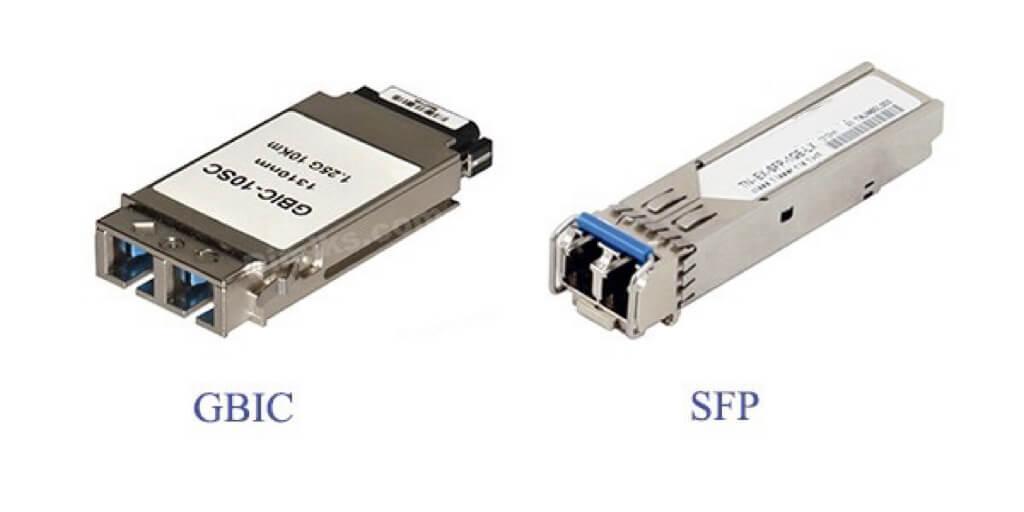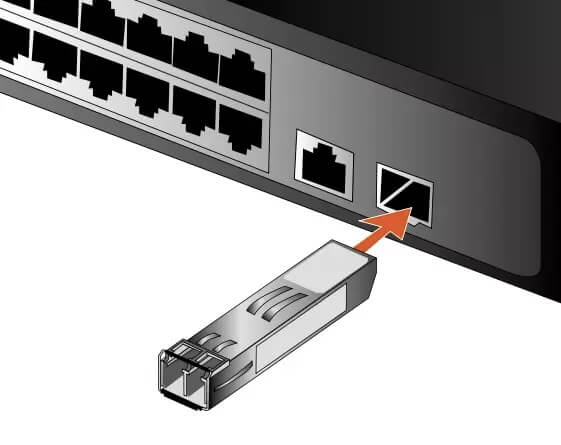These days, things can get confusing with all the choices available in the fiber optic market. But don’t worry, knowing about fiber optic equipment can really help you pick the right one for your needs. When it comes to transceiver modules, there are different types like GBIC, SFP, QSFP, CFP, and more, which might make you scratch your head. But let’s start with GBIC. This article aims to provide a clear overview of GBIC modules, including their types and a comparison between GBIC and SFP. So, let’s get started!
What is GBIC?
What is GBIC? GBIC, short for Gigabit Interface Converter, is a versatile optical transceiver that converts serial electric signals into optical ones. It seamlessly fits into the GBIC port on switches and routers, offering hot-pluggable convenience for easy insertion and removal without system shutdown.
With SC duplex interface, GBIC module works at the wavelength of 850nm to 1550nm and can transmit serial electric signals through the distance of 550m to 80km. It is a cost-effective choice for data centers and office buildings.
A Brief History of GBIC Transceiver
In 1995, the SFF Committee introduced the GBIC form factor and defined its specifications. The resulting MSA specification, SFF-8053 (or INF-8053), underwent updates over the years. The latest revision, Rev 5.5, was released on September 27, 2000.
(refer: https://en.wikipedia.org/wiki/Gigabit_interface_converter)
GBIC Transceiver Type
GBIC transceiver modules encompass a variety of types, differing in transfer protocol, wavelength, cable type, TX power, transmission distance, optical components, and receive sensitivity.
By Data Rate
- 100BASE: Suitable for fast Ethernet and SDH/SONET OC3.
- 622M: Designed for SDH/SONET OC12.
- 1G (1000BASE): Supports 1G fiber channel and gigabit Ethernet.
- 2G: Compatible with 2G fiber channel and 2.5G SDH/SONET.
By Cable Type
- RJ45 GBIC: Equipped with an RJ45 female connector, designed for Ethernet cable connections.
- Multimode GBIC: Designed for use with multimode fiber cables (OM1/OM2/OM3).
- Singlemode GBIC: Intended for use with singlemode fiber cables (OS1/OS2).
By Distance
- T: Copper variant, often with 1000BASE-T speed, transmitting over Cat 5 cable.
- SX: Short reach, typically covering 550m on OM2 fiber.
- LX: Long reach, usually spanning 10km on OS2 fiber.
- EX: Extended reach, typically covering 40km on OS2 fiber.
- ZX: Extended long reach, typically spanning 70km on OS2 fiber.
By Application
- CWDM: Coarse Wavelength Division Multiplexing maximizes fiber utilization efficiency.
- BiDi: Enables bi-directional transmission on a single fiber, saving cabling.
- Duplex Fiber: Transmits on one fiber and receives on another, suitable for regular duplex fiber cabling networks.
GBIC Connector vs GBIC Port vs GBIC Transceiver, What are the Differences?
In the world of networking, terms like GBIC connector, GBIC port, and transceiver may appear synonymous, yet they hold distinct meanings.
GBIC Port: Interface for Connectivity
A GBIC port is a physical interface found on gigabit switches and networking devices. It’s the entry point for GBIC form factor transceivers, encompassing both fiber and copper variants. Essentially a connector, it facilitates communication between the optical transceiver and the switch system. The port is typically a soldered component or group of components on the switch’s motherboard.
GBIC Connector: Transceiver Interface
The GBIC connector pertains to the interface found on the transceiver itself. Fiber transceivers feature duplex or simplex SC connectors, enabling direct connection with SC fiber cables. Conversely, copper transceivers incorporate RJ45 female connectors, catering to existing copper cabling networks like Cat5, Cat5e, or Cat6.
GBIC Transceiver: Communication Enabler
GBIC transceiver, also called GBIC module, it serves as the core device, enabling data transmission and reception. It slots into the GBIC port, forming a seamless link between the network device and the external medium, whether fiber optic or copper.
In summary, while these terms may seem related, they represent distinct components within the networking ecosystem. The GBIC port acts as an entry point, the GBIC connector is the interface on the transceiver, and the transceiver is the vital communication engine.
GBIC vs SFP, What are the Differences?
With the continuous enhancement of fiber optic technology, a breakthrough emerged – the mini GBIC. This compact innovation is hailed as a refined version of the standard GBIC. Despite being half the size, the mini GBIC maintains an equal data rate capability. It goes by the name Small Form Factor Pluggable (SFP) transceiver, a highly favored optical module prevalent in today’s market.
GBIC and SFP transceivers share several common attributes, such as hot-swap functionality and high-speed data transfers, serving Ethernet connections. However, noteworthy distinctions distinguish these two technologies.

GBIC vs SFP Connector
GBIC modules exclusively use SC connectors, while SFP modules utilize LC connectors. GBIC installation requires a duplex SC fiber, whereas SFP modules are paired with LC fiber.
GBIC vs SFP Size
SFP, an upgraded version of GBIC, boasts a significant size reduction. SFP’s smaller form factor allows for higher port density on switches, in contrast to the larger GBIC module.
GBIC vs SFP Compatibility
SFP exhibits greater versatility with variants like SFP+ and SFP28, supporting speeds of up to 10 Gbit/s and 25 Gbit/s. SFP+ and SFP28 modules maintain backward compatibility with SFP, enabling seamless use when plugged into respective ports.
GBIC and SFP work for 1Gbit data, but they differ in size. SFP is smaller, saving space for more interfaces on a switch. To decide, consider your situation:
- Existing Line Card: Choose GBIC or SFP based on your empty interface type.
- New Line Card: If getting a new line card, consider how many interfaces you need. SFP line cards are denser due to their smaller size.
Need 2 fiber interfaces? Go for a 2-port GBIC line card.
Using over 24 interfaces? A 48-port SFP line card is likely better.
GBIC Current Status
GBIC’s larger size demands more space, limiting ports and bandwidth. SFP’s compact size rapidly replaced GBIC. Modern switches favor SFP and SFP+ due to popularity, affordability, and variety.
Conclusion
Wondering about GBIC? Curious about GBIC types? Confused about choosing between GBIC and SFP? This article is your guide! By now, you’ve gained insights into these questions. Armed with this knowledge, you’re better equipped to select a GBIC or SFP transceiver that fits your needs.
If you’re still seeking further assistance or advice on GBIC or SFP optics, don’t hesitate to reach out.




